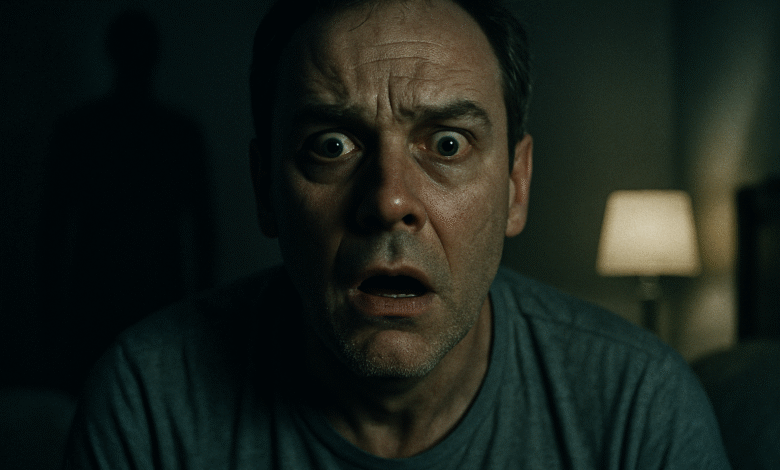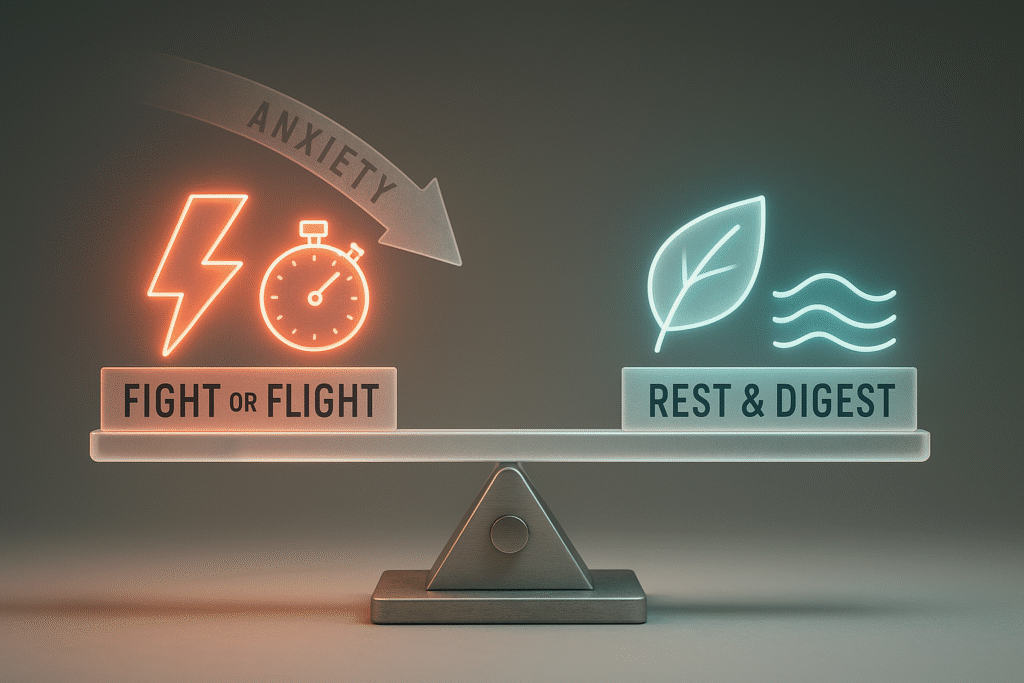It’s Not Your Testosterone. The Real Reason You’re Going Soft Is Hiding In Plain Sight.

Table of Contents

It’s the moment of truth, but instead of being present with your partner, you’re an anxious spectator watching a movie in your own head. The main character? You. The plot? A tense, second-by-second drama titled, “Will it work this time?” If this scene feels painfully familiar, you are not alone.
Have you heard of Psychological Erectile Dysfunction?
For millions of men over 40, this experience—”stage fright” in the bedroom—is a far more common culprit than low testosterone. It’s a vicious cycle where the fear of failure becomes the very cause of failure, turning intimacy into an ordeal. As of September 2025, a growing body of research from institutions like the Cleveland Clinic confirms that psychological factors are a primary driver of erectile issues, especially in men without underlying health conditions.
In this definitive guide, we’re going to put aside the myths and quick fixes. We will uncover the real reason this happens, not just on the surface, but deep in your brain’s wiring. More importantly, I’ll give you a concrete, multi-layered framework with actionable techniques to get out of your head, dismantle the anxiety machine, and reclaim your confidence so you can be a participant in your life again, not a spectator.
Part I: The Diagnosis – Understanding the True Culprit
Before we can solve the problem, we have to correctly identify it. For years, the default assumption for erectile issues has been purely physical: low hormones, poor circulation, or other medical conditions. While those are possibilities that must be ruled out, they are not the full story. For many of us, the battlefield is the mind.
Why Your Brain Hits the Brakes: Understanding “Fight or Flight” in the Bedroom

We’ve all heard of the “fight or flight” response. A stressful email from your boss, a car cutting you off in traffic—your heart pounds, your muscles tense, and your brain goes on high alert. This is your body’s ancient survival system kicking in, run by something called the sympathetic nervous system. Its sole purpose is to prepare you to either fight a threat or flee from it. To do this, it releases a cocktail of stress hormones, primarily adrenaline (epinephrine) and cortisol.
An erection, on the other hand, requires the exact opposite state. It relies on the parasympathetic nervous system, often called the “rest and digest” or “feed and breed” system. This is the state of calm that allows for relaxation, healthy digestion, and, crucially, the specific physiological processes required for sexual arousal. Think of these two systems like the pedals in a car: you can’t have the gas and the brake floored at the same time. They are mutually exclusive.
Here’s the critical link: your brain does not distinguish between a saber-toothed tiger and the fear of not performing.
When you feel that flicker of worry in the bedroom—”what if it doesn’t work?”—your brain perceives that thought as a legitimate threat. It interprets the “performance” as a stressful, high-stakes event and immediately slams on the emergency brake, triggering the “fight or flight” response. Adrenaline floods your system, and its primary job is vasoconstriction—the tightening of blood vessels. It does this to redirect blood away from non-essential functions (like digestion and, yes, an erection) and toward your major muscle groups to prepare you to run or fight.
This isn’t a personal failing; it’s a biological reflex. Your body is physically, hormonally, and neurologically doing the exact opposite of what’s needed for an erection. It’s preparing for battle, not for intimacy.
Expert Insight: Think of it like this: your body can’t prepare for a sprint and a marathon at the same time. When your brain senses stress, it diverts blood flow to your muscles to prepare you to run. It’s a survival reflex. This physical response is automatic and has nothing to do with your desire or attraction.
The Anxiety Spiral: Deconstructing the 4-Stage Loop That Keeps You Stuck
This isn’t a random event. It’s a predictable, repeatable loop that runs like a faulty program in your mind. It gains power with each repetition, digging the neural pathways deeper. Once you can see the distinct stages of this program, you can finally learn how to interrupt it.
Keep This ‘Circuit Breaker’ in Your Pocket
The 60-Second Reset is powerful, but memory fails when you’re under pressure. You can’t pull up this cheat sheet in the heat of the moment.
That’s why I’ve created a simple, beautifully designed Free PDF of this entire exercise. Save it to your phone’s home screen . It’s a discrete tool you can use to practice and master this technique, ensuring it’s right there when you need it most.
Take control now, and I’ll send it to you instantly.
Stage 1: The Anxious Trigger (The Seed of Doubt) It all starts with a thought, often born from a single past experience where things didn’t go as planned. It could have been due to fatigue, stress from work, or having too much to drink. The reason doesn’t matter. What matters is the memory. This memory creates a seed of doubt that lies dormant, waiting for the next intimate situation. The trigger isn’t the situation itself; it’s the anticipation of the situation. The “what if it happens again?” thought is the spark that lights the fuse.
Stage 2: Spectator Mode (The Mental Disconnect) As soon as the anxious thought appears, you mentally check out. You disconnect from the present moment and from your partner. Instead of being an engaged participant, you become an anxious observer, watching yourself from a distance and analyzing every sensation—or lack thereof. “Am I feeling enough?” “Is it working?” “What is she thinking?” This internal monologue is what many men describe as an “out-of-body” feeling. You’re no longer experiencing intimacy; you’re monitoring a performance.
Stage 3: The Adrenaline Rush (The Physical Sabotage) Your brain interprets this intense self-scrutiny and internal pressure as a clear sign of danger. It sounds the alarm, triggering the “fight or flight” response we just discussed. The adrenaline rush begins. Your heart may race, you might feel a knot in your stomach, and the blood flow necessary for an erection is actively diverted elsewhere. Your body is now physically working directly against your goal, confirming your initial fear.
Stage 4: The Negative Reinforcement (The “Proof”) When the erection inevitably falters due to this physiological cascade, your anxious brain doesn’t see the biological process. It screams, “See? I told you so! You have a problem.” This “failure” becomes the concrete, experiential proof that your fears were justified. This experience is logged in your memory, making the trigger for the next time even more potent and the anxiety spiral even more likely to begin. The loop is now complete, stronger, and more automated than before.
Part II: The Playbook – Actionable Strategies to Reclaim Control

Understanding the problem is the first step, but insight without action is useless. This section is the playbook. These are not quick fixes but foundational skills that, when practiced, will allow you to dismantle the anxiety machine piece by piece.
Foundational Skill 1: Cognitive Reframing – Rewiring Your Thoughts
Cognitive Reframing is a technique rooted in Cognitive Behavioral Therapy (CBT). It’s based on a simple premise: it’s not the event itself that causes our feelings, but our interpretation of the event. We need to change the distorted thoughts that fuel the anxiety spiral.
Technique A: Identify and Challenge Catastrophic Thinking “Catastrophic thinking” is when you take a single potential negative outcome and blow it up into an absolute disaster. In this context, the thought is: “If I don’t get an erection, it will be a catastrophe. She will be disappointed, she’ll think I’m not attracted to her, and it will be humiliating.”
- The Exercise: The 3 ‘C’s’
- Catch it: The moment you feel that anxious thought, consciously acknowledge it. Say to yourself, “There it is. The catastrophic thought.”
- Challenge it: Interrogate the thought like a lawyer. Is it 100% true that this will be a catastrophe? Has it been a catastrophe before, or was it just an awkward moment that passed? What’s a more realistic outcome? (e.g., “It might be awkward for a moment, but we can do other things. Our relationship is stronger than this single moment.”)
- Change it: Replace the catastrophic thought with a more balanced and realistic one. Instead of “This will be a disaster,” try: “My self-worth is not tied to a perfect performance. The goal is connection, not just intercourse. We can be intimate in many ways.”
Technique B: Shifting from a “Performance” to a “Pleasure” Frame The very idea of “performance” creates a pass/fail dynamic. This is the root of the pressure. You must consciously shift your internal goal.
- The Exercise: Define a New “Win” Before any intimate encounter, take 30 seconds to mentally (or even verbally with your partner) redefine the goal for the evening.
- Old Goal (Performance Frame): “I must achieve and maintain an erection for intercourse.” (Pass/Fail)
- New Goal (Pleasure Frame): “My goal is to explore intimacy and shared pleasure with my partner. I will focus on what feels good for both of us in this moment.” (Exploratory, no failure state)
This isn’t just wordplay. By removing the pass/fail condition, you remove the source of the threat that triggers the anxiety spiral.
Common Mistake: Many men double down on porn or visual stimulation, thinking they need more arousal. This often backfires by increasing the pressure to ‘perform’ up to an unrealistic standard, feeding the anxiety it’s meant to solve.
Foundational Skill 2: Mindfulness & Sensory Grounding – Mastering the Moment
Mindfulness is the practice of bringing your attention to the present moment without judgment. It is the single most powerful antidote to “spectator mode.”
Technique A: The 5-Minute Daily Breath Anchor This is your gym workout for your attention muscle. The stronger it gets, the easier it will be to deploy it when you need it most.
- The Practice: Every day, for just 5 minutes, sit in a quiet place. Close your eyes. Your only job is to focus on the physical sensation of your breath—the air entering your nostrils, your chest rising and falling. When your mind wanders (and it will), gently and without judgment, guide your focus back to your breath. That’s it. The “rep” isn’t in holding your focus; it’s in the gentle act of returning it again and again.
Technique B: In-the-Moment Sensory Grounding This is your emergency escape hatch when you feel yourself slipping into spectator mode during intimacy. The goal is to get out of your head and back into your body by overwhelming your brain with present-moment sensory information.
- The Practice (The 5-4-3-2-1 Method): When you feel the anxiety rising, discretely shift your focus.
- Mentally name FIVE things you can see (the pattern on the sheets, the color of the wall).
- Focus on FOUR things you can physically feel (the texture of your partner’s skin, the weight of the blanket, the temperature of the air).
- Listen for THREE things you can hear (your partner’s breathing, a distant sound outside).
- Identify TWO things you can smell.
- Focus on ONE thing you can taste.
This exercise forces your brain to disengage from the anxious internal narrative and re-engage with the physical reality of the present moment, which can calm the “fight or flight” response.
Foundational Skill 3: The Partner as an Ally – Communication Scripts
You are not in this alone. Hiding the struggle and trying to power through it turns your partner into an unwitting source of pressure. Bringing them in as a teammate is a game-changer.
The Fear: “If I tell her what’s going on, she’ll think I’m broken, or that I’m not attracted to her.” The Reality: Most partners are incredibly relieved. They’ve likely sensed the tension and may have been blaming themselves, thinking they are the problem. Your honesty gives them clarity and a role to play.
The “Pre-Game” Conversation (To have outside the bedroom): Choose a neutral time when you’re both relaxed.
- The Script: “I want to talk about something that’s been on my mind. Lately, I’ve been feeling a lot of pressure in the bedroom, and I get in my head, which makes it hard for me to stay present. It has absolutely nothing to do with you or how much I desire you. It’s just this frustrating anxiety loop. I’m working on it, and what would help me most is if we could just take the pressure off and focus on having fun and connecting, without any specific expectations.”
The “In-the-Moment” Signal: Agree on a simple, low-key word or phrase you can use if you feel yourself getting anxious.
- The Script: “What if we agreed that if I start feeling stuck in my head, I can just say ‘Let’s pause’ or ‘Let’s just breathe for a second’? It would help me reset without making a big deal out of it.”
This turns a moment of panic into a collaborative act of reconnecting.
Foundational Skill 4: Lifestyle Optimization – Stacking the Deck in Your Favor
While the primary issue is psychological, your physical state has a massive impact on your mental resilience. Optimizing your lifestyle makes you less susceptible to anxiety triggers.
- Sleep: Chronic sleep deprivation raises cortisol levels, the primary stress hormone. This means you start the day already closer to a “fight or flight” state. Prioritizing 7-8 hours of quality sleep is non-negotiable.
- Exercise: Intense cardiovascular exercise and resistance training are proven to reduce anxiety and improve blood flow. They also provide a powerful sense of competence and mastery over your body, which directly counteracts feelings of helplessness.
- Alcohol & Diet: Excessive alcohol is a depressant and directly impacts erectile function. A diet high in processed foods can lead to inflammation and sluggishness. Focus on a clean diet to ensure your body and brain have the fuel they need to operate optimally. Your physical well-being is the foundation upon which your mental well-being is built.
Part III: The Integration – Putting It All Together
When to See a Doctor: Ruling Out the Physical First
This guide focuses on the psychological, but we must be smart and responsible. Before you dedicate yourself solely to these mental techniques, it is essential to consult a physician to get a clean bill of health.
The Conversation Starter: This isn’t an embarrassing conversation; it’s a health conversation. Your doctor has had it hundreds of times. Be direct: “I’ve been experiencing some performance anxiety and erectile issues, and I’d like to do a full check-up to rule out any underlying physical causes.”
What to Ask For:
- A full blood panel: This should include testosterone levels (Total and Free T), but also thyroid function, blood sugar (A1C to check for diabetes), and cholesterol.
- A blood pressure check: High blood pressure is a leading physical cause of ED.
- A discussion about your cardiovascular health: An erection is fundamentally a cardiovascular event. Issues with erections can sometimes be an early warning sign of broader heart health problems.
Getting a clean bill of health is a massive psychological win. It removes the nagging doubt of “what if it’s something physical?” and allows you to focus 100% of your energy on mastering the mental game.
Conclusion: From Anxious Spectator to Confident Participant

The reason performance anxiety feels so impossible is that we fight it on the wrong battlefield. We think it’s a battle with our bodies, a sign of aging, or a loss of manhood. It is none of those things. It is simply a battle for your focus. It is a faulty mental loop—a bug in the system that can be debugged and rewritten.
This is not an overnight fix. It is a process of building skills. You are learning to direct your attention, challenge your thoughts, and communicate more openly. Each time you catch the catastrophic thinking, each time you successfully ground yourself in the present moment, you weaken the old neural pathways and build new, healthier ones.
By understanding how the anxiety spiral works and consistently applying these strategies, you can stop being a spectator in your own life. You can break the cycle, get out of your head, and be the confident, present partner you want to be. The real reason has been hiding in plain sight: it’s your focus. And the good news is, you are in complete control of where you place it.
Quick Action: For the next week, commit to the 5-Minute Daily Breath Anchor exercise. This is the single most important step in training your brain to redirect focus—the core skill you’ll use to defeat performance anxiety in the moment.
Disclaimer: This content provides educational information only and should not replace professional medical advice. Performance anxiety and erectile dysfunction can be linked to serious health conditions. Individual circumstances vary significantly. Consult a qualified physician for a full diagnosis and personalized guidance.







